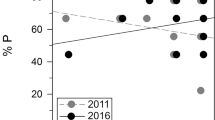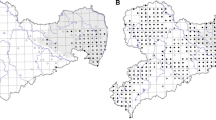Abstract
The introduced subspecies of the common reed (Phragmites australis (Cav.) Trin. ex Steud. subsp. australis; Poaceae) is considered one of the most invasive plants in North American wetlands. Given its relatively low seed set and its tremendous capacity to spread via stolons or rhizomes, it has generally been thought that the spread of vegetative diaspores was responsible for the establishment of new populations. To test this hypothesis, we sampled a single plant from each of 345 visually-distinct common reed stands located along the shores of Lake St. François (southern Quebec, Canada). With a set of six nuclear microsatellite markers, we distinguished 134 different genotypes. The number of individuals sharing the same genotype ranged from one to 16, and averaged 2.1. Most genotypes were encountered only once. We examined the spatial distribution of the most frequent genotypes and found little evidence of clusters along the lakeshore. These data contradict the hypothesis that a common reed invasion is initiated by the introduction of vegetative diaspores from a few clones. Rather, they clearly support the alternative hypothesis that seeds were the primary diaspores responsible for the establishment of common reed populations.



Similar content being viewed by others
References
Benoit LK, Askins RA (1999) Impact of the spread of Phragmites on the distribution of birds in Connecticut tidal marshes. Wetlands 19:194–208
Bertness MD, Ewanchuk PJ, Silliman BR (2002) Anthropogenic modification of New England salt marsh landscapes. Proc Natl Acad Sci USA 99:1395–1398
Brisson J, Paradis É, Bellavance M-È (2008) Evidence of sexual reproduction in the invasive common reed (Phragmites australis subsp. australis; Poaceae) in eastern Canada: a possible consequence of global warming? Rhodora 110:225–230
Chambers RM, Meyerson LA, Saltonstall K (1999) Expansion of Phragmites australis into tidal wetlands of North America. Aquat Bot 64:261–273
Clark PJ, Evans FC (1954) Distance to the nearest neighbour as a measure of spatial relationships in populations. Ecology 35:445–453
Cressie NAC (1993) Statistics for spatial data, 2nd edn. Wiley, New York
Edwards K, Johnstone C, Thompson C (1991) A simple and rapid method for the preparation of plant genomic DNA for PCR analysis. Nucleic Acids Res 19:1349
Fér T, Hroudová Z (2009) Genetic diversity and dispersal of Phragmites australis in a small river system. Aquat Bot 90:165–171
Gervais C, Trahan R, Moreno D, Drolet A-M (1993) Le Phragmites australis au Québec: distribution géographique, nombres chromosomiques, et reproduction. Can J Bot 71:1386–1393
Hanson SR, Osgood DT, Yozzo DJ (2002) Nekton use of a Phragmites australis marsh on the Hudson River, New York, USA. Wetlands 22:326–337
Hudon C, Gagnon P, Jean M (2005) Hydrological factors controlling the spread of common reed (Phragmites australis) in the St. Lawrence River (Québec, Canada). Écoscience 12:347–357
Hunter KL, Fox DA, Brown LM, Able KW (2006) Responses of resident marsh fishes to stages of Phragmites australis invasion in three mid Atlantic estuaries. Estuar Coast 29:487–498
Ishii J, Kadono Y (2002) Factors influencing seed production of Phragmites australis. Aquat Bot 72:129–141
Jodoin Y, Lavoie C, Villeneuve P, Thériault M, Beaulieu J, Belzile F (2008) Highways as corridors and habitats for the invasive common reed Phragmites australis in Quebec, Canada. J Appl Ecol 45:459–466
Keller BEM (2000) Plant diversity in Lythrum, Phragmites, and Typha marshes, Massachusetts, USA. Wetl Ecol Manag 8:391–401
Koppitz H, Kühl H (2000) To the importance of genetic diversity of Phragmites australis in the development of reed stands. Wetl Ecol Manag 8:403–414
Koppitz H, Kühl H, Hesse K, Kohl J-G (1997) Some aspects of the importance of genetic diversity in Phragmites australis (Cav.) Trin. ex Steudel for the development of reed stands. Bot Acta 110:217–223
Lathrop RG, Windham L, Montesano P (2003) Does Phragmites expansion alter the structure and function of marsh landscapes? Patterns and processes revisited. Estuaries 26:423–435
Lavergne S, Molofsky J (2007) Increased genetic variation and evolutionary potential drive the success of an invasive grass. Proc Natl Acad Sci USA 104:3883–3888
Lavoie C, Jean M, Delisle F, Létourneau G (2003) Exotic plant species of the St. Lawrence River wetlands: a spatial and historical analysis. J Biogeogr 30:537–549
League MT, Colbert EP, Seliskar DM, Gallagher JL (2006) Rhizome growth dynamics of native and exotic haplotypes of Phragmites australis (common reed). Estuar Coast 29:269–276
LeBlanc M-C (2008) Quels sont les facteurs qui expliquent l’envahissement des berges du Grand lac Saint-François par le roseau commun (Phragmites australis)? M. ATDR Thesis, Université Laval, Quebec City
Lelong B, Lavoie C, Jodoin Y, Belzile F (2007) Expansion pathways of the exotic common reed (Phragmites australis): a historical and genetic analysis. Divers Distrib 13:430–437
Lelong B, Lavoie C, Thériault M (2009) Quels sont les facteurs qui facilitent l’implantation du roseau commun (Phragmites australis) le long des routes du sud du Québec? Écoscience 16:224–237
Maheu-Giroux M, de Blois S (2007) Landscape ecology of Phragmites australis invasion in networks of linear wetlands. Landsc Ecol 22:285–301
Mal TK, Narine L (2004) The biology of Canadian weeds. 129. Phragmites australis (Cav.) Trin. ex Steud. Can J Plant Sci 84:365–396
McKee J, Richards AJ (1996) Variation in seed production and germinability in common reed (Phragmites australis) in Britain and France with respect to climate. New Phytol 133:233–243
Minchinton TE (2006) Rafting on wrack as a mode of dispersal for plants in coastal marshes. Aquat Bot 84:372–376
Ministère du Loisir, de la Chasse et de la Pêche du Québec (1986) Parc de Frontenac: le plan directeur. Ministère du Loisir, de la Chasse et de la Pêche du Québec, Direction de l’aménagement, Service des plans directeurs, Quebec City
Moody ML, Les DH (2002) Evidence of hybridity in invasive watermilfoil (Myriophyllum) populations. Proc Natl Acad Sci USA 99:14867–14871
Osgood DT, Yozzo DJ, Chambers RM, Jacobson D, Hoffman T, Wnek J (2003) Tidal hydrology and habitat utilization by resident nekton in Phragmites and non-Phragmites marshes. Estuaries 26:522–533
Philipp KR, Field RT (2005) Phragmites australis expansion in Delaware Bay salt marshes. Ecol Eng 25:275–291
Rice D, Rooth J, Stevenson JC (2000) Colonization and expansion of Phragmites australis in upper Chesapeake Bay tidal marshes. Wetlands 20:280–299
Robertson TL, Weis JS (2005) A comparison of epifaunal communities associated with the stems of salt marsh grasses Phragmites australis and Spartina alterniflora. Wetlands 25:1–7
Robitaille A, Saucier J-P (1998) Paysages régionaux du Québec méridional. Publications du Québec, Sainte-Foy
Saltonstall K (2002) Cryptic invasion by a non-native genotype of the common reed, Phragmites australis, into North America. Proc Natl Acad Sci USA 99:2445–2449
Saltonstall K (2003) A rapid method for identifying the origin of North American Phragmites populations using RFLP analysis. Wetlands 23:1043–1047
Silliman BR, Bertness MD (2004) Shoreline development drives invasion of Phragmites australis and the loss of plant diversity on New England salt marshes. Conserv Biol 18:1424–1434
Société des établissements de plein air du Québec (2005) Suivi des populations de roseau commun (Phragmites communis) le long du lac Saint-François. Société des établissements de plein air du Québec, Quebec City
Trebitz AS, Taylor DL (2007) Exotic and invasive aquatic plants in Great Lakes coastal wetlands: distribution and relation to watershed land use and plant richness and cover. J Great Lakes Res 33:705–721
Tulbure MG, Johnston CA, Auger DL (2007) Rapid invasion of a Great Lakes coastal wetland by non-native Phragmites australis and Typha. J Great Lakes Res 33(special issue 3):269–279
Warren RS, Fell PE, Grimsby JL, Buck EL, Rilling GC, Fertik RA (2001) Rates, patterns, and impacts of Phragmites australis expansion and effects of experimental Phragmites control on vegetation, macroinvertebrates, and fish within tidelands of the lower Connecticut River. Estuaries 24:90–107
White DA, Hauber DP, Hood CS (2004) Clonal differences in Phragmites australis from the Mississippi River delta. Southeast Nat 3:531–544
Wilcox KL, Petrie SA, Maynard LA, Meyer SW (2003) Historical distribution and abundance of Phragmites australis at Long Point, Lake Erie, Ontario. J Great Lakes Res 29:664–680
Windham L, Lathrop RG (1999) Effects of Phragmites australis (common reed) invasion on aboveground biomass and soil properties in brackish tidal marsh of the Mullica River, New Jersey. Estuaries 26:452–464
Acknowledgments
This research was financially supported (grants to F. Belzile and C. Lavoie; scholarship to J. Labbé) by the Natural Sciences and Engineering Research Council of Canada, and by the Frontenac National Park. We are grateful to M. Jean and A. Saint-Louis for laboratory assistance, and to J. Dubé for his help with statistical analyses.
Author information
Authors and Affiliations
Corresponding author
Rights and permissions
About this article
Cite this article
Belzile, F., Labbé, J., LeBlanc, MC. et al. Seeds contribute strongly to the spread of the invasive genotype of the common reed (Phragmites australis). Biol Invasions 12, 2243–2250 (2010). https://doi.org/10.1007/s10530-009-9634-x
Received:
Accepted:
Published:
Issue Date:
DOI: https://doi.org/10.1007/s10530-009-9634-x




